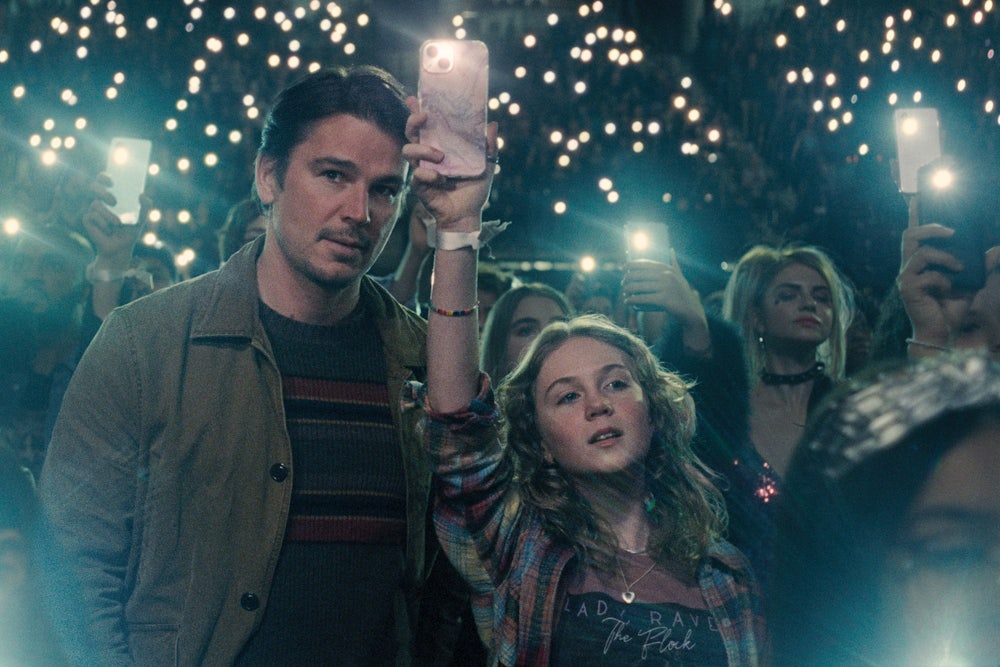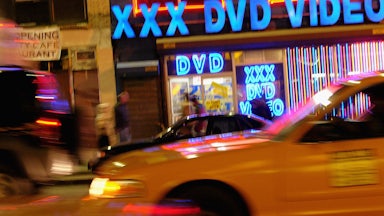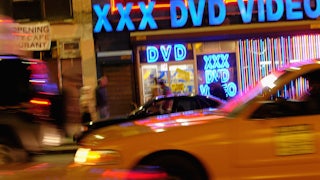Having scored floor seats for himself and his teenage daughter at a sold-out stadium date by the world’s reigning pop star, a distracted dad spends the majority of the show looking desperately for a way out: “Let me know what I miss,” he tells her on his umpteenth head-clearing walk to the merch table. Such is the wry generational joshing informing M. Night Shyamalan’s latest thriller, Trap, which speaks to our present pop-cultural moment with the same stilted, earnest eloquence that is its writer-director’s stock in trade, even as it wrings variations on his pet concerns and preoccupations, including parental anxiety, surveillance, and the essentially paranoid texture of everyday life. Twenty-five years into a career whose trajectory is at least as twistily implausible as his screenplays, Shyamalan has fused together showmanship and self-awareness in the manner of a seasoned popular entertainer; by turns gripping and goofy—and directly angled toward mainstream consumption while slyly addressing his most committed fans—Trap is M. Night’s Eras Tour.
Certainly, the early scenes will resonate with any major dude who’s ever tried awkwardly bonding with their offspring over a Spotify playlist. Converging on downtown Philadelphia (semi-successfully impersonated by Toronto) with twenty thousand other concertgoers—including a conspicuous contingent of daddy-daughter dates—Cooper (Josh Hartnett) and Riley (Ariel Donoghue) make small talk about the latter’s undying love for the music of one Lady Raven (Saleka), a sleekly imperious singer-songwriter who appears to be an amalgamation of twenty-first-century chart-toppers (Lady Gaga, Olivia Rodrigo, and the post-country incarnation of Taylor Swift). The messianic dimension of contemporary divadom is a rich subject, and the conceit is deepened by the casting of Shyamalan’s daughter, Saleka, a real-life R&B performer who wrote and performed the film’s entire soundtrack. Her participation, which keeps her in the background of nearly every scene for a solid stretch of screen time, is the first and sweetest of Trap’s two significant conceptual coups. In making a movie about a father attempting a grand gesture of affection for his offspring, Shyamalan has crafted a custom-made and very public showcase for his own kid to show off her chops—a blatant, ecstatic rejoinder to the past year’s nepo-baby discourse.
The second conceptual coup is that Cooper—played by Harnett beneath lank hair and a convincing suburban uniform of off-the-rack plaid—is a serial killer. More specifically, he is a tabloid fixture known as “The Butcher,” an elusive cipher whose grisly methodology and spiraling body count have made him a household name in Pennsylvania and elsewhere. The Butcher is in good company in the MNCU (M. Night Cinematic Universe), alongside such extravagantly nicknamed antagonists as Mr. Glass (Unbreakable), The Horde (Split), and The Ones We Do Not Speak Of (The Village). The character he most resembles, however, in a fascinatingly inverted way, is David Dunn, the protagonist of Unbreakable, whose accidental discovery of submerged superpowers turns him into a sort of reluctant, clandestine public defender.
The primary DNA of Unbreakable was familiar but potently distilled comic-book pulp: a melancholy riff on the superhero truism that with great power comes great responsibility. Still, the late scene where the sad-eyed, lantern-jawed David (wonderfully played by Bruce Willis) wordlessly reveals his secret identity to his teenage son by pointing to a newspaper cartoonist’s rendering of himself as a nobly hooded sentinel felt suffused with a mythic mixture of love and dread—a complex tableau of hero worship for a movie that was ahead of the Marvel curve. The premise of Trap, meanwhile, is that Cooper, whose affable normie act belies an apex predator’s situational awareness, is essentially a supervillain—one who swiftly realizes that the entire Lady Raven extravaganza is an elaborate sting to ensnare him. Cooper’s fight or flight instincts are strong, but he’s compromised: Because he doesn’t want to abandon Riley—or worse, have her discover his diabolical double life—he has to holster his killer instincts on the spot and meekly evade detection until the final curtain.
As high concepts go, “What if Hannibal Lecter but Dad jokes?” is at once dizzyingly vertiginous and slightly low-hanging fruit, and in order to properly appreciate the meticulously jerry-rigged contraption of Trap, you also have to accept that it’s fundamentally sort of silly. For many viewers (and critics) the hushed, slow-burning severity of The Sixth Sense remains the most haunting and persuasive expression of Shyamalan’s neo-Lewton artistry, but real heads have charted his incremental mutation into a grinning practical joker, a shift complicated by his earnestness. At this point, rehearsing the laundry list of accusations against Shyamalan’s dialogue and dramaturgy—starting with his apparent deficiencies in conveying naturalistic, everyday conversation—is less interesting than the stubbornness with which he sticks to his guns. When Cooper presses a chatty T-shirt vendor for further details about the FBI’s plan to apprehend the Butcher—which, apparently, is dependent on the cooperation of the stadium’s entire small army of staffers, as well as that of Lady Raven and her entourage—their back-and-forth exchange (“This whole concert is a trap!”) could almost be a parody of B-movie exposition—or an acknowledgment by a veteran filmmaker that he’s hovering above the proceedings.
Except that he’s not. Whatever else one can say about Shyamalan—pro or con—his deconstructionist side comes from a place of genuine respect and affection. Recall that the notorious (and underrated) “bedtime story” Lady in the Water was a movie about protecting a nymph named Story from evildoers, and you get a sense of Shyamalan’s religious faith in narrative; even if his approach can skirt (or sometimes sink) into convolution—into a litany of fastidiously delineated rules, limits, and gimmicks—he works to play fair with the audience on whatever terms he’s set. Such straightforwardness is, in and of itself, a balm: In a moment when a younger generation of horror filmmakers are celebrated for “elevating” their material, Shyamalan focuses solely on execution. Shot in swooping, fluid camera movements by the gifted Thai cinematographer Sayombhu Mukdeeprom, Trap is elegant and propulsive, especially in its first half, but it’s also got some welcome dilapidation around the edges: Instead of trying to gentrify genre, its maker is happy to inhabit it.
Home, it should be said, is where the heart is in Shyamalan’s cinema, and it’s also a consistent locus of horror: The most unsettling sequences of his career were the ones in Unbreakable where a hulking sociopath took an entire family prisoner, forcibly occupying their residence in a terrifying pantomime of residential-neighborhood normalcy (“This is a nice house … can I come in?”). Without getting too deep into the weeds about Trap’s plot, or the extent to which it does or doesn’t commit to its initial escape-room conceit, it does eventually intersect significantly with Shyamalan’s enduring themes of domesticity. Yet where he often gives us images of home intrusion, this time the proverbial call is coming from inside the house. The structural and logistical engineering by which Trap maneuvers its featured characters into differently dangerous locations and configurations is simultaneously intricate and outrageous: The question, which grows more urgent and skeptical as Trap barrels along, is whether all this humid, hothouse atmosphere will ultimately yield the same torrential downpours of feeling as Unbreakable, Lady in the Water, or 2021’s Old, which didn’t so much transcend its neo–Twilight Zone logline of a cove whose visitors age with unnatural speed (say it with me: “There’s something wrong with this beach!”) as unlock the transcendence latent within it.
Spoiler alert: It doesn’t, or at least not enough to gain the film entry to the first rank of Shyamalan’s filmography. Auteurism can be a slippery slope, and for those of us sympathetic to both Shyamalan’s virtuoso style and his guileless sensibility (a tougher sell for the realist-cynic film critics sent up so memorably by Lady in the Water’s tweedy human villain), it’s tempting to argue that Trap’s various ostensible deficiencies are in fact subtle or eccentric strengths. For instance: If one were to say the Lady Raven concert isn’t quite convincing as Swiftian spectacle, that could be taken as evidence of wry music industry satire, à la Old’s hilarious inclusion of a Top 40 hip-hopper dubbed “Mid-Sized Sedan.” Similarly, the fact that Shyamalan has made an almost completely spotless, bloodless film about a guy called “The Butcher” might be finessed as a critique of multiplex squeamishness, or even a by-product of Cooper’s oft-invoked—and convincingly acted—obsessive-compulsive disorder.
As for the glaring unlikelihood of certain encounters occurring the way they do, well, that’s cinema for you. If you don’t like it, you’re one of what Alfred Hitchcock called, uncomplimentarily, the “Plausibles.” Still, it’s possible to acknowledge that Trap’s singular and self-contained nature is a welcome respite from so much serialized, methodically interlocking studio product—and also to praise it for its suggestive juxtaposition of pop-cultural rituals and and primal fears—while noting that it doesn’t quite work overall. Beyond the quasi-Hitchockian cleverness of making us complicit in the antihero’s innovative array of exit strategies, Shyamalan doesn’t take us anywhere especially deep here. The idea of the lone wolf draped strategically in woolly-patriarchal clothing was already perfected nearly forty years ago in Joseph Ruben’s artfully trashy chiller The Stepfather, which yoked the violence wrought by its Ted Bundy–ish namesake to a gory burlesque of Reagan-era values. While Shyamalan has been a political filmmaker in the past, most palpably in the color-coded “war on terror” allegory of The Village, Trap is too anodyne to say much about pent-up, murderous masculinity except that it exists; a late monologue by a secondary character about the proliferation of sociopaths living quietly in our midst feels distinctly like a case of gilding the lily.
There is, perhaps, a reading of Trap in which Cooper’s monstrous and increasingly taxing balancing act between civility and savagery can be taken as a form of artistic self-portraiture—as an expression of Shyamalan’s fears about being swallowed up by his own vocation (the opening credits, with their abstract diagrams of vivisected body parts, are like a visual metonym for film editing). Trap only really honors this autofictional conceit insofar as Cooper, like Shyamalan, is defined by his abilities as a mechanical, moment-by-moment problem solver. That the final shot directly quotes one of Hitchcock’s greatest hits is at once amusing and fair enough, given Shyamalan’s not-inconsiderable stature and aspirations. But it also draws a distinction between a classic whose meanings (intentional and otherwise) have only opened up over time and an accomplished minor misfire that closes in so tightly on itself that there’s nothing left over.






